Analysis of Southcorp Limited Case in Business and Corporate Law
VerifiedAdded on 2021/06/14
|11
|2659
|79
Report
AI Summary
This report presents a comprehensive analysis of the Australian Securities and Investments Commission (ASIC) v. Southcorp Limited case, focusing on the breach of continuous disclosure obligations under the Corporations Act 2001. The case revolves around Southcorp's failure to promptly inform the Australian Stock Exchange (ASX) about the expected impact of its 2000 vintage wines, which would have implied reduced sales and profits. The report details the breach of duties, the court's critical analysis, and the relevance of the decision to the operation of Australian companies. The court found Southcorp in contravention of its disclosure obligations, highlighting the importance of timely and accurate information dissemination to maintain market integrity. The report examines the implications of selective disclosure, the role of good faith, and the civil penalty imposed on the company. The analysis emphasizes the fundamental nature of continuous disclosure as a legal obligation for listed entities and its impact on investor confidence and market efficiency. The report concludes by underscoring the significance of compliance with legal provisions to avoid civil penalties and maintain the integrity of the Australian market.
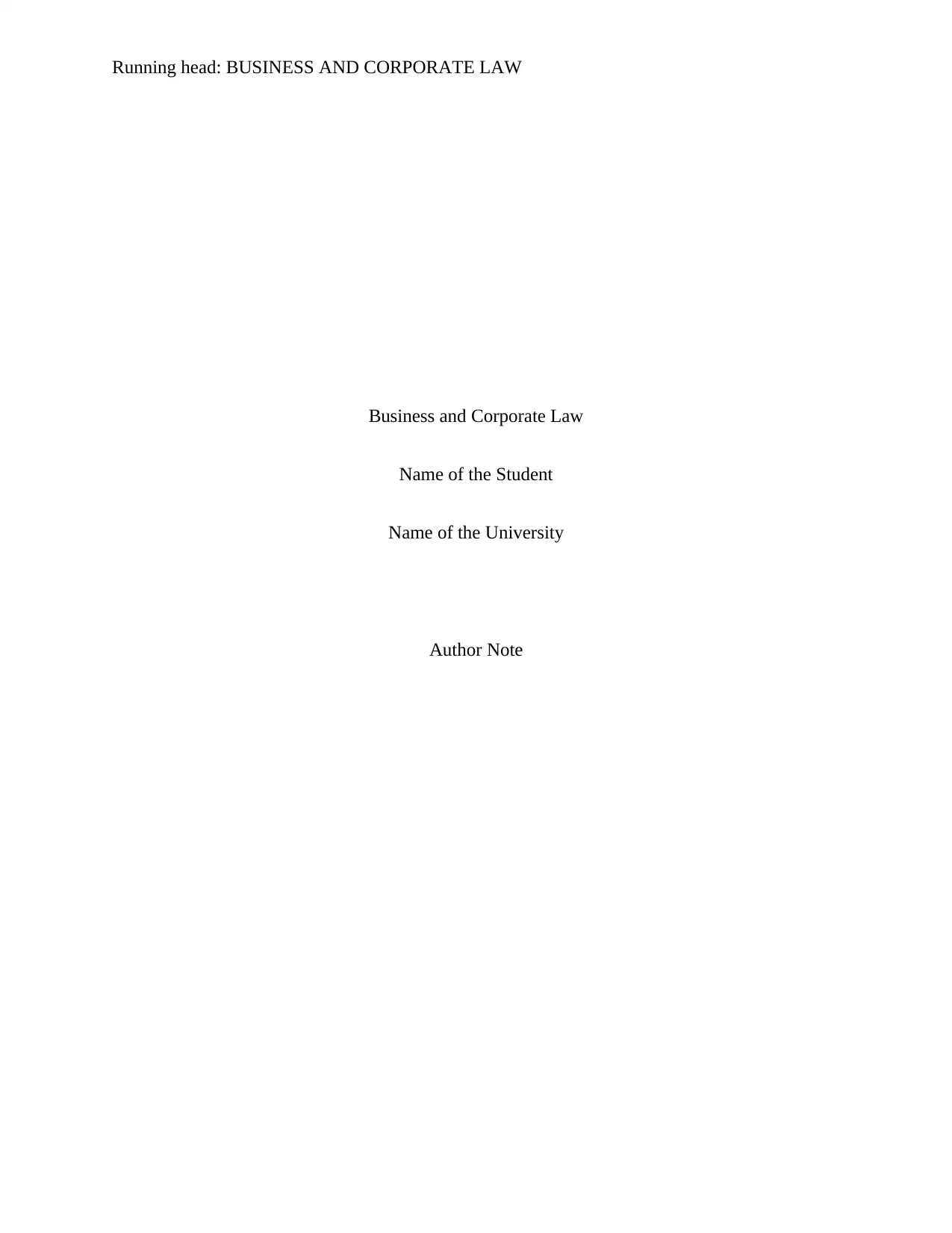
Running head: BUSINESS AND CORPORATE LAW
Business and Corporate Law
Name of the Student
Name of the University
Author Note
Business and Corporate Law
Name of the Student
Name of the University
Author Note
Paraphrase This Document
Need a fresh take? Get an instant paraphrase of this document with our AI Paraphraser
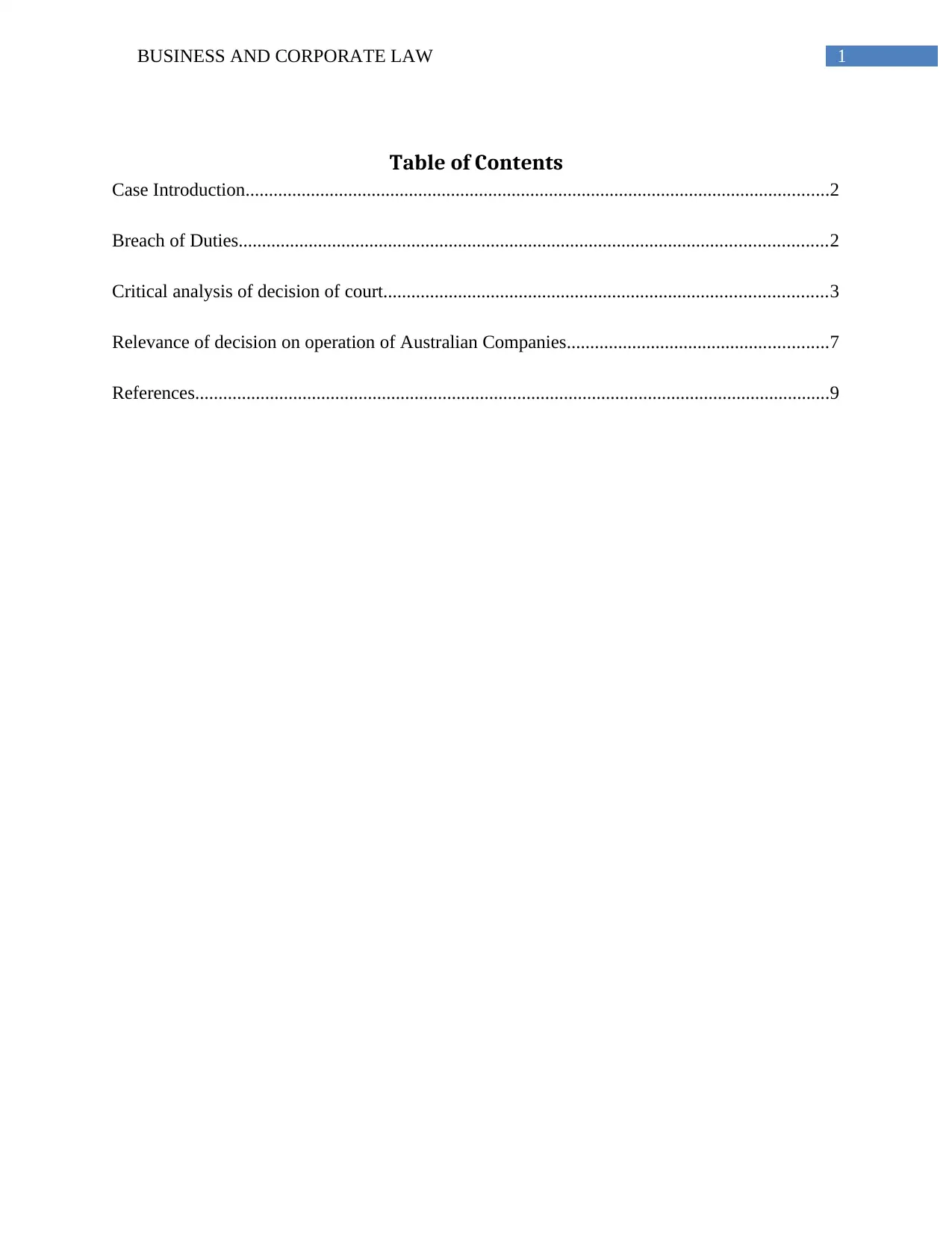
1BUSINESS AND CORPORATE LAW
Table of Contents
Case Introduction.............................................................................................................................2
Breach of Duties..............................................................................................................................2
Critical analysis of decision of court...............................................................................................3
Relevance of decision on operation of Australian Companies........................................................7
References........................................................................................................................................9
Table of Contents
Case Introduction.............................................................................................................................2
Breach of Duties..............................................................................................................................2
Critical analysis of decision of court...............................................................................................3
Relevance of decision on operation of Australian Companies........................................................7
References........................................................................................................................................9
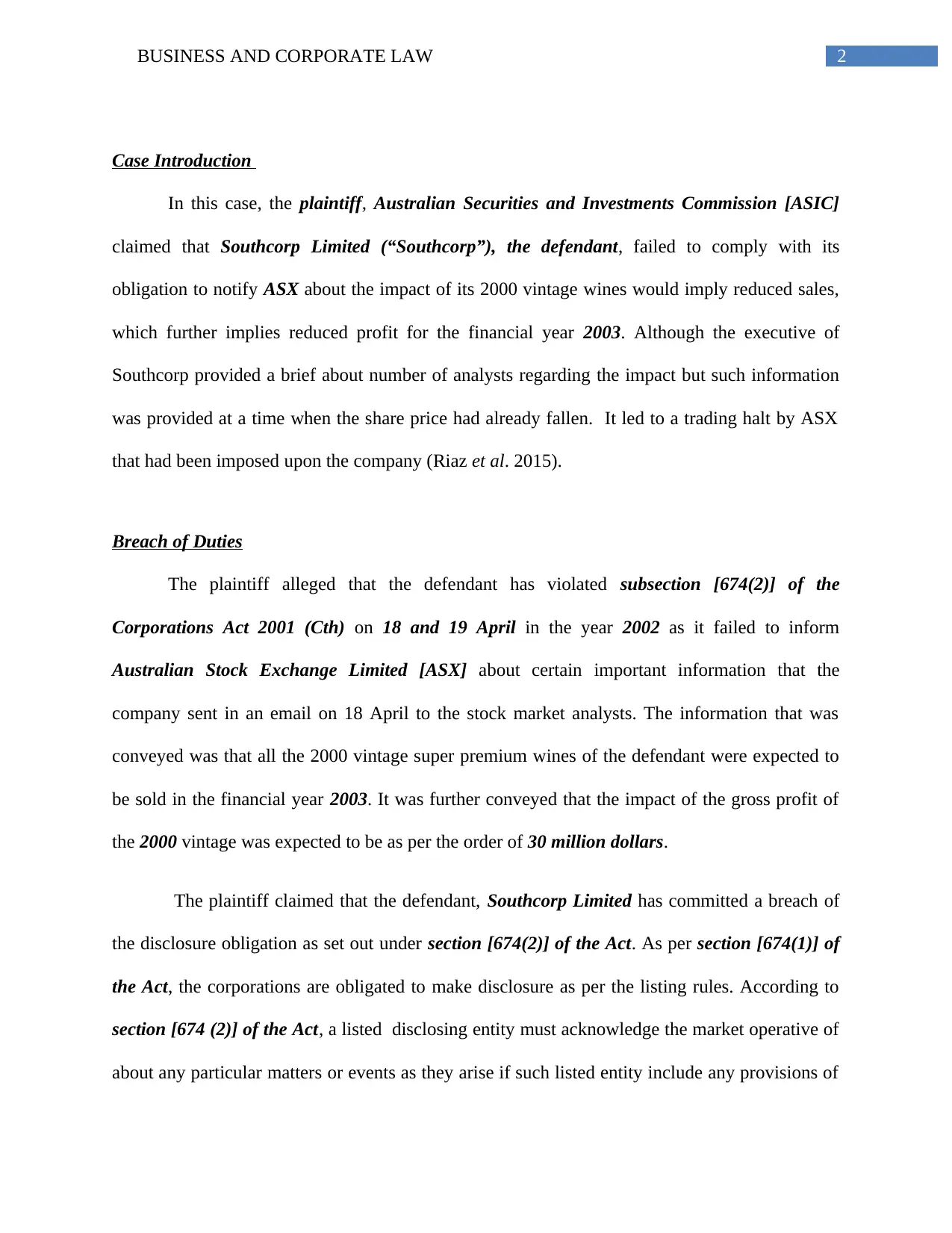
2BUSINESS AND CORPORATE LAW
Case Introduction
In this case, the plaintiff, Australian Securities and Investments Commission [ASIC]
claimed that Southcorp Limited (“Southcorp”), the defendant, failed to comply with its
obligation to notify ASX about the impact of its 2000 vintage wines would imply reduced sales,
which further implies reduced profit for the financial year 2003. Although the executive of
Southcorp provided a brief about number of analysts regarding the impact but such information
was provided at a time when the share price had already fallen. It led to a trading halt by ASX
that had been imposed upon the company (Riaz et al. 2015).
Breach of Duties
The plaintiff alleged that the defendant has violated subsection [674(2)] of the
Corporations Act 2001 (Cth) on 18 and 19 April in the year 2002 as it failed to inform
Australian Stock Exchange Limited [ASX] about certain important information that the
company sent in an email on 18 April to the stock market analysts. The information that was
conveyed was that all the 2000 vintage super premium wines of the defendant were expected to
be sold in the financial year 2003. It was further conveyed that the impact of the gross profit of
the 2000 vintage was expected to be as per the order of 30 million dollars.
The plaintiff claimed that the defendant, Southcorp Limited has committed a breach of
the disclosure obligation as set out under section [674(2)] of the Act. As per section [674(1)] of
the Act, the corporations are obligated to make disclosure as per the listing rules. According to
section [674 (2)] of the Act, a listed disclosing entity must acknowledge the market operative of
about any particular matters or events as they arise if such listed entity include any provisions of
Case Introduction
In this case, the plaintiff, Australian Securities and Investments Commission [ASIC]
claimed that Southcorp Limited (“Southcorp”), the defendant, failed to comply with its
obligation to notify ASX about the impact of its 2000 vintage wines would imply reduced sales,
which further implies reduced profit for the financial year 2003. Although the executive of
Southcorp provided a brief about number of analysts regarding the impact but such information
was provided at a time when the share price had already fallen. It led to a trading halt by ASX
that had been imposed upon the company (Riaz et al. 2015).
Breach of Duties
The plaintiff alleged that the defendant has violated subsection [674(2)] of the
Corporations Act 2001 (Cth) on 18 and 19 April in the year 2002 as it failed to inform
Australian Stock Exchange Limited [ASX] about certain important information that the
company sent in an email on 18 April to the stock market analysts. The information that was
conveyed was that all the 2000 vintage super premium wines of the defendant were expected to
be sold in the financial year 2003. It was further conveyed that the impact of the gross profit of
the 2000 vintage was expected to be as per the order of 30 million dollars.
The plaintiff claimed that the defendant, Southcorp Limited has committed a breach of
the disclosure obligation as set out under section [674(2)] of the Act. As per section [674(1)] of
the Act, the corporations are obligated to make disclosure as per the listing rules. According to
section [674 (2)] of the Act, a listed disclosing entity must acknowledge the market operative of
about any particular matters or events as they arise if such listed entity include any provisions of
⊘ This is a preview!⊘
Do you want full access?
Subscribe today to unlock all pages.

Trusted by 1+ million students worldwide
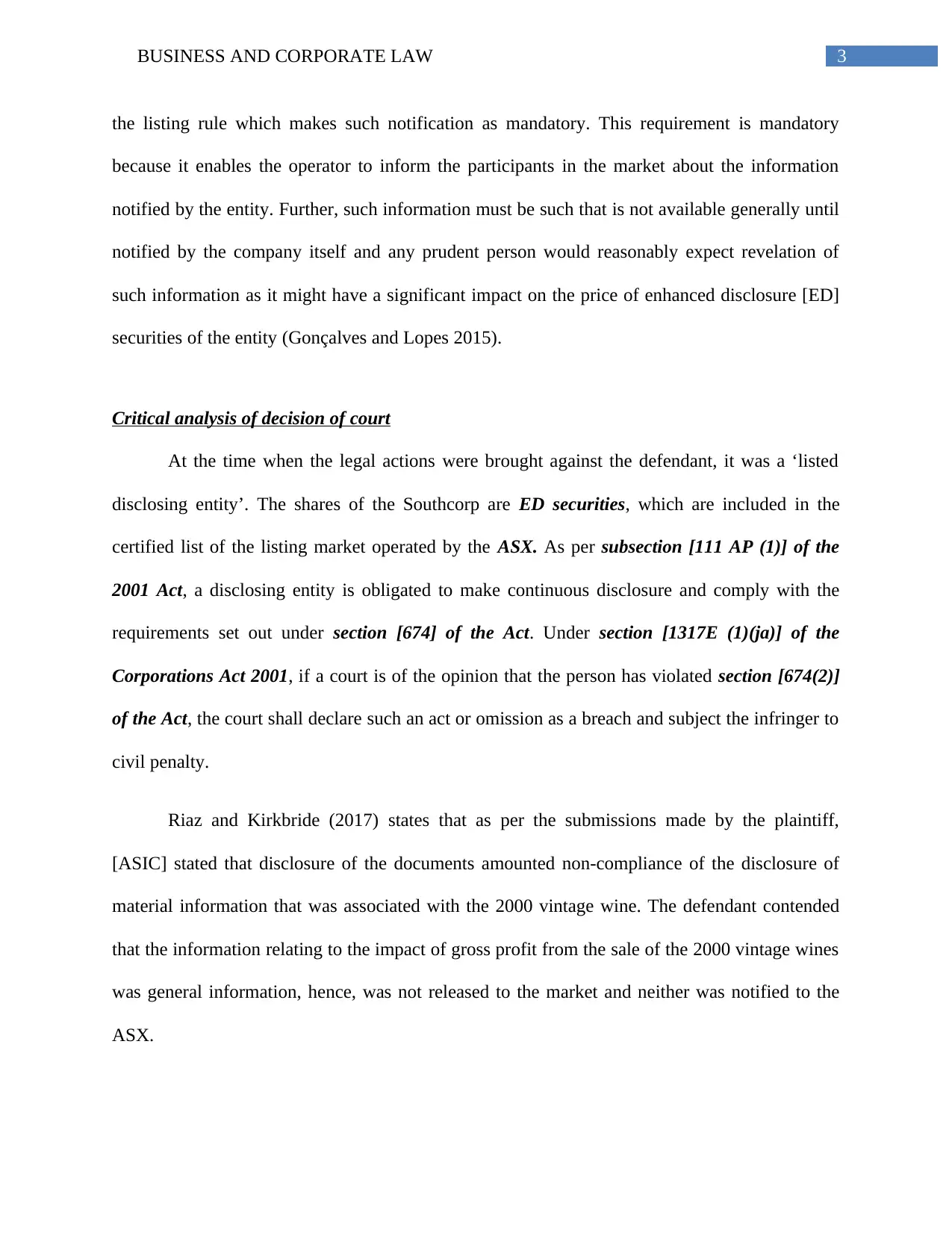
3BUSINESS AND CORPORATE LAW
the listing rule which makes such notification as mandatory. This requirement is mandatory
because it enables the operator to inform the participants in the market about the information
notified by the entity. Further, such information must be such that is not available generally until
notified by the company itself and any prudent person would reasonably expect revelation of
such information as it might have a significant impact on the price of enhanced disclosure [ED]
securities of the entity (Gonçalves and Lopes 2015).
Critical analysis of decision of court
At the time when the legal actions were brought against the defendant, it was a ‘listed
disclosing entity’. The shares of the Southcorp are ED securities, which are included in the
certified list of the listing market operated by the ASX. As per subsection [111 AP (1)] of the
2001 Act, a disclosing entity is obligated to make continuous disclosure and comply with the
requirements set out under section [674] of the Act. Under section [1317E (1)(ja)] of the
Corporations Act 2001, if a court is of the opinion that the person has violated section [674(2)]
of the Act, the court shall declare such an act or omission as a breach and subject the infringer to
civil penalty.
Riaz and Kirkbride (2017) states that as per the submissions made by the plaintiff,
[ASIC] stated that disclosure of the documents amounted non-compliance of the disclosure of
material information that was associated with the 2000 vintage wine. The defendant contended
that the information relating to the impact of gross profit from the sale of the 2000 vintage wines
was general information, hence, was not released to the market and neither was notified to the
ASX.
the listing rule which makes such notification as mandatory. This requirement is mandatory
because it enables the operator to inform the participants in the market about the information
notified by the entity. Further, such information must be such that is not available generally until
notified by the company itself and any prudent person would reasonably expect revelation of
such information as it might have a significant impact on the price of enhanced disclosure [ED]
securities of the entity (Gonçalves and Lopes 2015).
Critical analysis of decision of court
At the time when the legal actions were brought against the defendant, it was a ‘listed
disclosing entity’. The shares of the Southcorp are ED securities, which are included in the
certified list of the listing market operated by the ASX. As per subsection [111 AP (1)] of the
2001 Act, a disclosing entity is obligated to make continuous disclosure and comply with the
requirements set out under section [674] of the Act. Under section [1317E (1)(ja)] of the
Corporations Act 2001, if a court is of the opinion that the person has violated section [674(2)]
of the Act, the court shall declare such an act or omission as a breach and subject the infringer to
civil penalty.
Riaz and Kirkbride (2017) states that as per the submissions made by the plaintiff,
[ASIC] stated that disclosure of the documents amounted non-compliance of the disclosure of
material information that was associated with the 2000 vintage wine. The defendant contended
that the information relating to the impact of gross profit from the sale of the 2000 vintage wines
was general information, hence, was not released to the market and neither was notified to the
ASX.
Paraphrase This Document
Need a fresh take? Get an instant paraphrase of this document with our AI Paraphraser
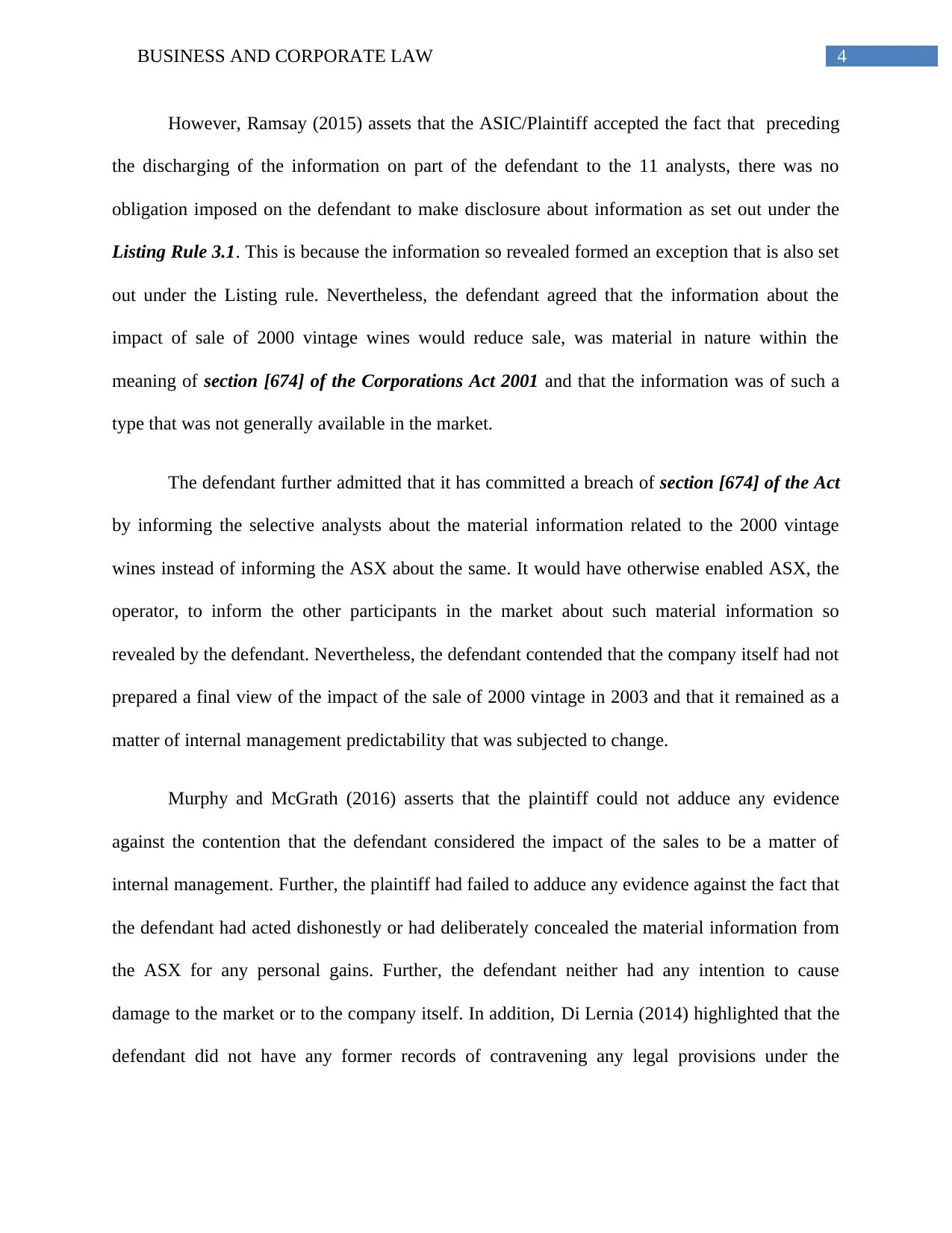
4BUSINESS AND CORPORATE LAW
However, Ramsay (2015) assets that the ASIC/Plaintiff accepted the fact that preceding
the discharging of the information on part of the defendant to the 11 analysts, there was no
obligation imposed on the defendant to make disclosure about information as set out under the
Listing Rule 3.1. This is because the information so revealed formed an exception that is also set
out under the Listing rule. Nevertheless, the defendant agreed that the information about the
impact of sale of 2000 vintage wines would reduce sale, was material in nature within the
meaning of section [674] of the Corporations Act 2001 and that the information was of such a
type that was not generally available in the market.
The defendant further admitted that it has committed a breach of section [674] of the Act
by informing the selective analysts about the material information related to the 2000 vintage
wines instead of informing the ASX about the same. It would have otherwise enabled ASX, the
operator, to inform the other participants in the market about such material information so
revealed by the defendant. Nevertheless, the defendant contended that the company itself had not
prepared a final view of the impact of the sale of 2000 vintage in 2003 and that it remained as a
matter of internal management predictability that was subjected to change.
Murphy and McGrath (2016) asserts that the plaintiff could not adduce any evidence
against the contention that the defendant considered the impact of the sales to be a matter of
internal management. Further, the plaintiff had failed to adduce any evidence against the fact that
the defendant had acted dishonestly or had deliberately concealed the material information from
the ASX for any personal gains. Further, the defendant neither had any intention to cause
damage to the market or to the company itself. In addition, Di Lernia (2014) highlighted that the
defendant did not have any former records of contravening any legal provisions under the
However, Ramsay (2015) assets that the ASIC/Plaintiff accepted the fact that preceding
the discharging of the information on part of the defendant to the 11 analysts, there was no
obligation imposed on the defendant to make disclosure about information as set out under the
Listing Rule 3.1. This is because the information so revealed formed an exception that is also set
out under the Listing rule. Nevertheless, the defendant agreed that the information about the
impact of sale of 2000 vintage wines would reduce sale, was material in nature within the
meaning of section [674] of the Corporations Act 2001 and that the information was of such a
type that was not generally available in the market.
The defendant further admitted that it has committed a breach of section [674] of the Act
by informing the selective analysts about the material information related to the 2000 vintage
wines instead of informing the ASX about the same. It would have otherwise enabled ASX, the
operator, to inform the other participants in the market about such material information so
revealed by the defendant. Nevertheless, the defendant contended that the company itself had not
prepared a final view of the impact of the sale of 2000 vintage in 2003 and that it remained as a
matter of internal management predictability that was subjected to change.
Murphy and McGrath (2016) asserts that the plaintiff could not adduce any evidence
against the contention that the defendant considered the impact of the sales to be a matter of
internal management. Further, the plaintiff had failed to adduce any evidence against the fact that
the defendant had acted dishonestly or had deliberately concealed the material information from
the ASX for any personal gains. Further, the defendant neither had any intention to cause
damage to the market or to the company itself. In addition, Di Lernia (2014) highlighted that the
defendant did not have any former records of contravening any legal provisions under the
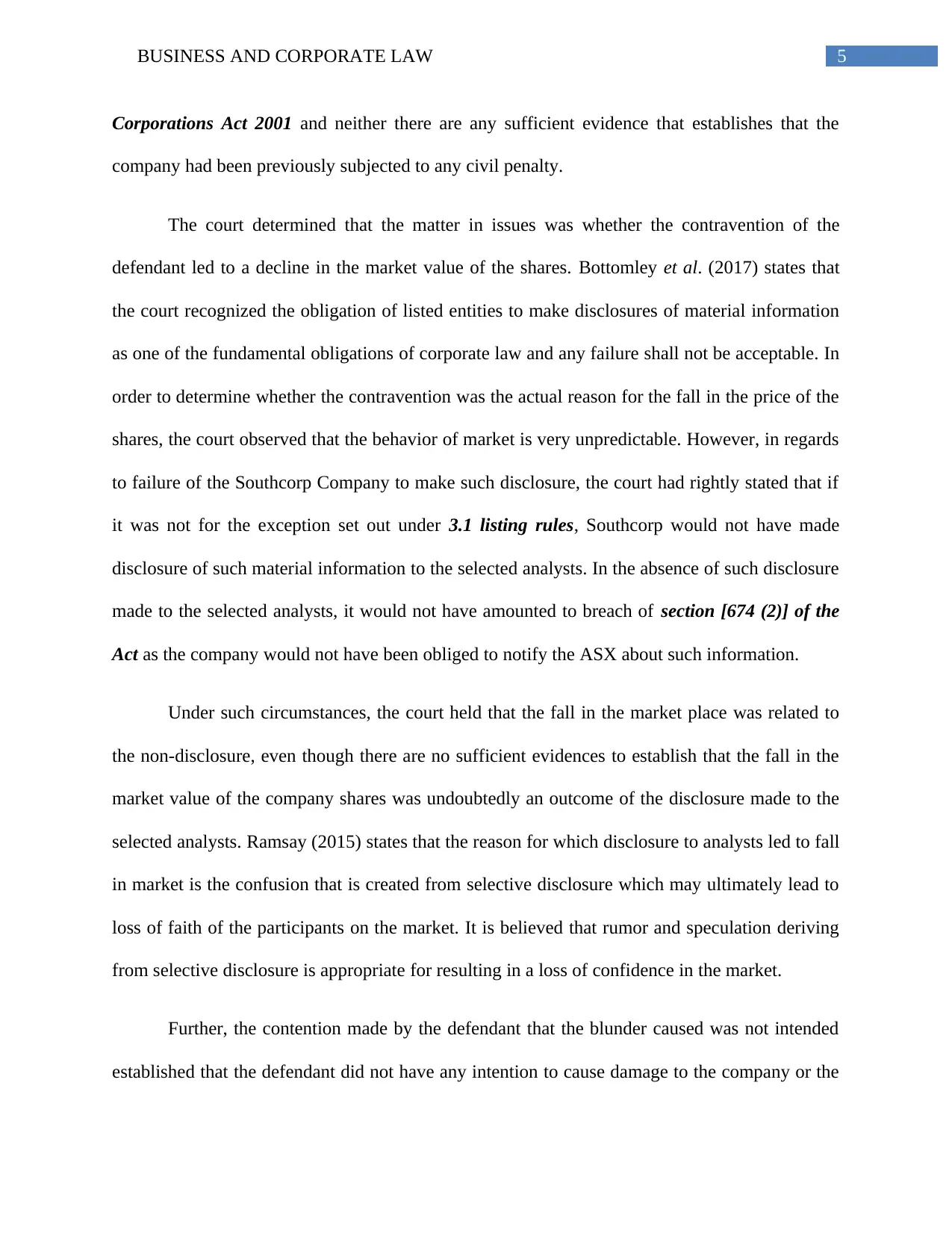
5BUSINESS AND CORPORATE LAW
Corporations Act 2001 and neither there are any sufficient evidence that establishes that the
company had been previously subjected to any civil penalty.
The court determined that the matter in issues was whether the contravention of the
defendant led to a decline in the market value of the shares. Bottomley et al. (2017) states that
the court recognized the obligation of listed entities to make disclosures of material information
as one of the fundamental obligations of corporate law and any failure shall not be acceptable. In
order to determine whether the contravention was the actual reason for the fall in the price of the
shares, the court observed that the behavior of market is very unpredictable. However, in regards
to failure of the Southcorp Company to make such disclosure, the court had rightly stated that if
it was not for the exception set out under 3.1 listing rules, Southcorp would not have made
disclosure of such material information to the selected analysts. In the absence of such disclosure
made to the selected analysts, it would not have amounted to breach of section [674 (2)] of the
Act as the company would not have been obliged to notify the ASX about such information.
Under such circumstances, the court held that the fall in the market place was related to
the non-disclosure, even though there are no sufficient evidences to establish that the fall in the
market value of the company shares was undoubtedly an outcome of the disclosure made to the
selected analysts. Ramsay (2015) states that the reason for which disclosure to analysts led to fall
in market is the confusion that is created from selective disclosure which may ultimately lead to
loss of faith of the participants on the market. It is believed that rumor and speculation deriving
from selective disclosure is appropriate for resulting in a loss of confidence in the market.
Further, the contention made by the defendant that the blunder caused was not intended
established that the defendant did not have any intention to cause damage to the company or the
Corporations Act 2001 and neither there are any sufficient evidence that establishes that the
company had been previously subjected to any civil penalty.
The court determined that the matter in issues was whether the contravention of the
defendant led to a decline in the market value of the shares. Bottomley et al. (2017) states that
the court recognized the obligation of listed entities to make disclosures of material information
as one of the fundamental obligations of corporate law and any failure shall not be acceptable. In
order to determine whether the contravention was the actual reason for the fall in the price of the
shares, the court observed that the behavior of market is very unpredictable. However, in regards
to failure of the Southcorp Company to make such disclosure, the court had rightly stated that if
it was not for the exception set out under 3.1 listing rules, Southcorp would not have made
disclosure of such material information to the selected analysts. In the absence of such disclosure
made to the selected analysts, it would not have amounted to breach of section [674 (2)] of the
Act as the company would not have been obliged to notify the ASX about such information.
Under such circumstances, the court held that the fall in the market place was related to
the non-disclosure, even though there are no sufficient evidences to establish that the fall in the
market value of the company shares was undoubtedly an outcome of the disclosure made to the
selected analysts. Ramsay (2015) states that the reason for which disclosure to analysts led to fall
in market is the confusion that is created from selective disclosure which may ultimately lead to
loss of faith of the participants on the market. It is believed that rumor and speculation deriving
from selective disclosure is appropriate for resulting in a loss of confidence in the market.
Further, the contention made by the defendant that the blunder caused was not intended
established that the defendant did not have any intention to cause damage to the company or the
⊘ This is a preview!⊘
Do you want full access?
Subscribe today to unlock all pages.

Trusted by 1+ million students worldwide
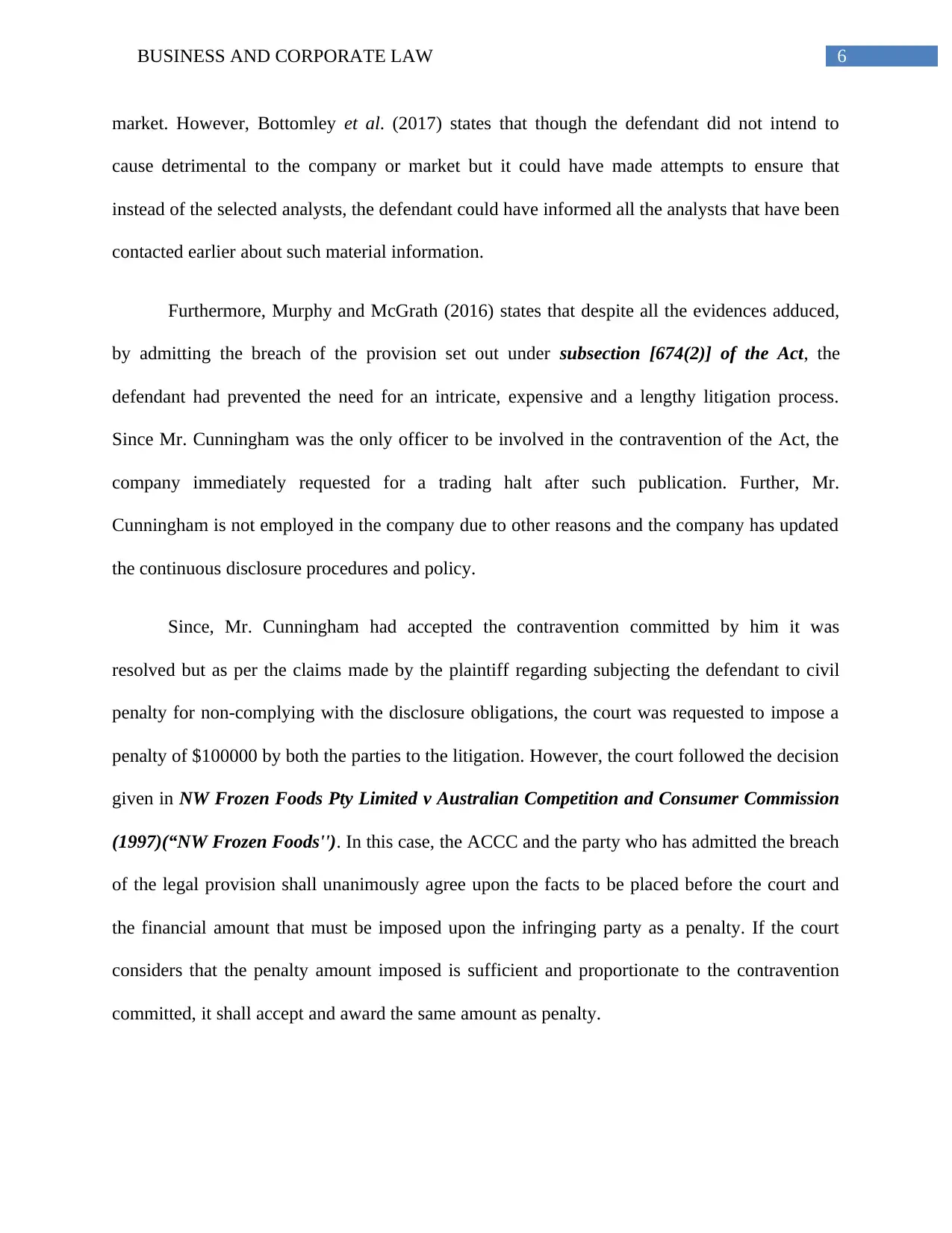
6BUSINESS AND CORPORATE LAW
market. However, Bottomley et al. (2017) states that though the defendant did not intend to
cause detrimental to the company or market but it could have made attempts to ensure that
instead of the selected analysts, the defendant could have informed all the analysts that have been
contacted earlier about such material information.
Furthermore, Murphy and McGrath (2016) states that despite all the evidences adduced,
by admitting the breach of the provision set out under subsection [674(2)] of the Act, the
defendant had prevented the need for an intricate, expensive and a lengthy litigation process.
Since Mr. Cunningham was the only officer to be involved in the contravention of the Act, the
company immediately requested for a trading halt after such publication. Further, Mr.
Cunningham is not employed in the company due to other reasons and the company has updated
the continuous disclosure procedures and policy.
Since, Mr. Cunningham had accepted the contravention committed by him it was
resolved but as per the claims made by the plaintiff regarding subjecting the defendant to civil
penalty for non-complying with the disclosure obligations, the court was requested to impose a
penalty of $100000 by both the parties to the litigation. However, the court followed the decision
given in NW Frozen Foods Pty Limited v Australian Competition and Consumer Commission
(1997)(“NW Frozen Foods''). In this case, the ACCC and the party who has admitted the breach
of the legal provision shall unanimously agree upon the facts to be placed before the court and
the financial amount that must be imposed upon the infringing party as a penalty. If the court
considers that the penalty amount imposed is sufficient and proportionate to the contravention
committed, it shall accept and award the same amount as penalty.
market. However, Bottomley et al. (2017) states that though the defendant did not intend to
cause detrimental to the company or market but it could have made attempts to ensure that
instead of the selected analysts, the defendant could have informed all the analysts that have been
contacted earlier about such material information.
Furthermore, Murphy and McGrath (2016) states that despite all the evidences adduced,
by admitting the breach of the provision set out under subsection [674(2)] of the Act, the
defendant had prevented the need for an intricate, expensive and a lengthy litigation process.
Since Mr. Cunningham was the only officer to be involved in the contravention of the Act, the
company immediately requested for a trading halt after such publication. Further, Mr.
Cunningham is not employed in the company due to other reasons and the company has updated
the continuous disclosure procedures and policy.
Since, Mr. Cunningham had accepted the contravention committed by him it was
resolved but as per the claims made by the plaintiff regarding subjecting the defendant to civil
penalty for non-complying with the disclosure obligations, the court was requested to impose a
penalty of $100000 by both the parties to the litigation. However, the court followed the decision
given in NW Frozen Foods Pty Limited v Australian Competition and Consumer Commission
(1997)(“NW Frozen Foods''). In this case, the ACCC and the party who has admitted the breach
of the legal provision shall unanimously agree upon the facts to be placed before the court and
the financial amount that must be imposed upon the infringing party as a penalty. If the court
considers that the penalty amount imposed is sufficient and proportionate to the contravention
committed, it shall accept and award the same amount as penalty.
Paraphrase This Document
Need a fresh take? Get an instant paraphrase of this document with our AI Paraphraser
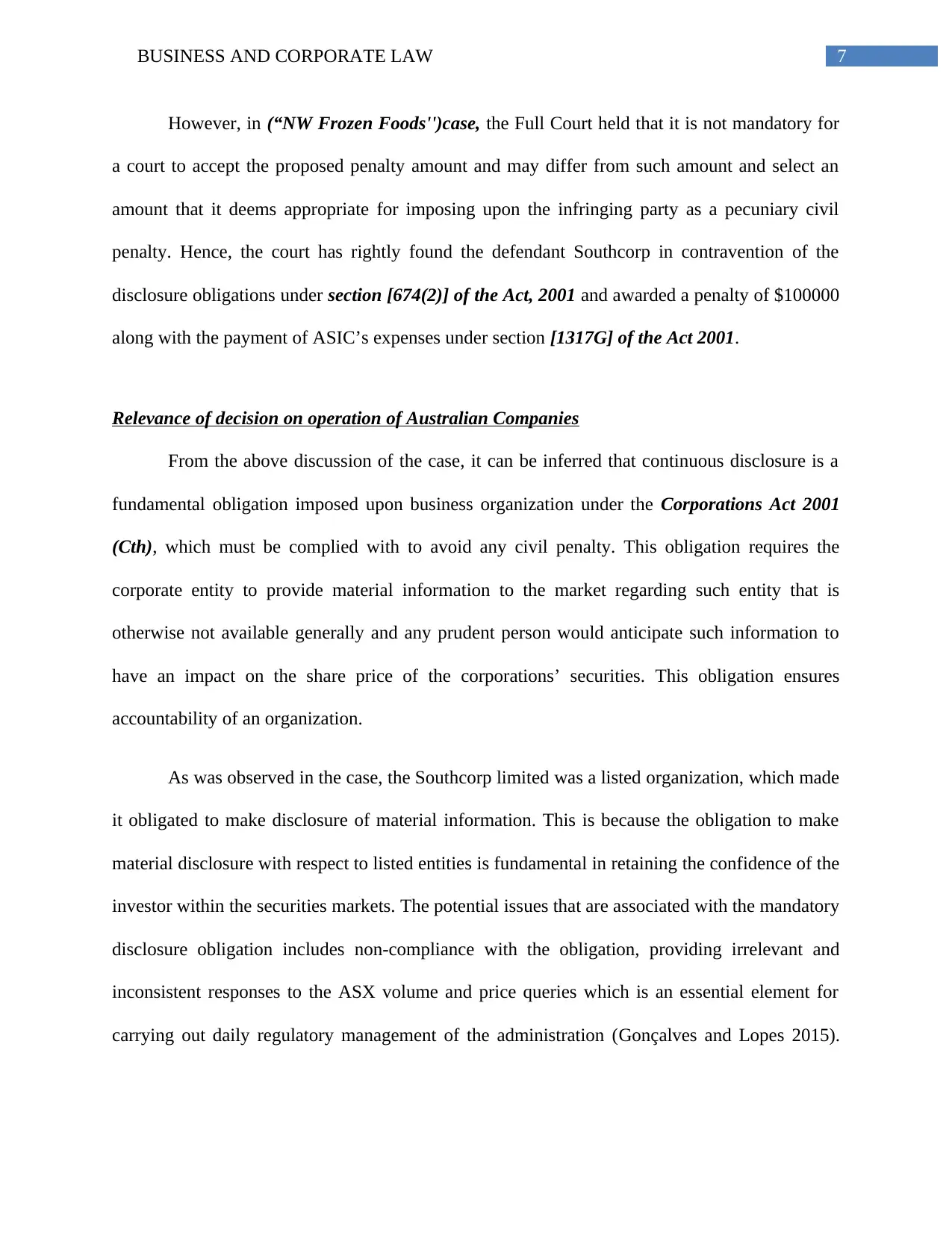
7BUSINESS AND CORPORATE LAW
However, in (“NW Frozen Foods'')case, the Full Court held that it is not mandatory for
a court to accept the proposed penalty amount and may differ from such amount and select an
amount that it deems appropriate for imposing upon the infringing party as a pecuniary civil
penalty. Hence, the court has rightly found the defendant Southcorp in contravention of the
disclosure obligations under section [674(2)] of the Act, 2001 and awarded a penalty of $100000
along with the payment of ASIC’s expenses under section [1317G] of the Act 2001.
Relevance of decision on operation of Australian Companies
From the above discussion of the case, it can be inferred that continuous disclosure is a
fundamental obligation imposed upon business organization under the Corporations Act 2001
(Cth), which must be complied with to avoid any civil penalty. This obligation requires the
corporate entity to provide material information to the market regarding such entity that is
otherwise not available generally and any prudent person would anticipate such information to
have an impact on the share price of the corporations’ securities. This obligation ensures
accountability of an organization.
As was observed in the case, the Southcorp limited was a listed organization, which made
it obligated to make disclosure of material information. This is because the obligation to make
material disclosure with respect to listed entities is fundamental in retaining the confidence of the
investor within the securities markets. The potential issues that are associated with the mandatory
disclosure obligation includes non-compliance with the obligation, providing irrelevant and
inconsistent responses to the ASX volume and price queries which is an essential element for
carrying out daily regulatory management of the administration (Gonçalves and Lopes 2015).
However, in (“NW Frozen Foods'')case, the Full Court held that it is not mandatory for
a court to accept the proposed penalty amount and may differ from such amount and select an
amount that it deems appropriate for imposing upon the infringing party as a pecuniary civil
penalty. Hence, the court has rightly found the defendant Southcorp in contravention of the
disclosure obligations under section [674(2)] of the Act, 2001 and awarded a penalty of $100000
along with the payment of ASIC’s expenses under section [1317G] of the Act 2001.
Relevance of decision on operation of Australian Companies
From the above discussion of the case, it can be inferred that continuous disclosure is a
fundamental obligation imposed upon business organization under the Corporations Act 2001
(Cth), which must be complied with to avoid any civil penalty. This obligation requires the
corporate entity to provide material information to the market regarding such entity that is
otherwise not available generally and any prudent person would anticipate such information to
have an impact on the share price of the corporations’ securities. This obligation ensures
accountability of an organization.
As was observed in the case, the Southcorp limited was a listed organization, which made
it obligated to make disclosure of material information. This is because the obligation to make
material disclosure with respect to listed entities is fundamental in retaining the confidence of the
investor within the securities markets. The potential issues that are associated with the mandatory
disclosure obligation includes non-compliance with the obligation, providing irrelevant and
inconsistent responses to the ASX volume and price queries which is an essential element for
carrying out daily regulatory management of the administration (Gonçalves and Lopes 2015).
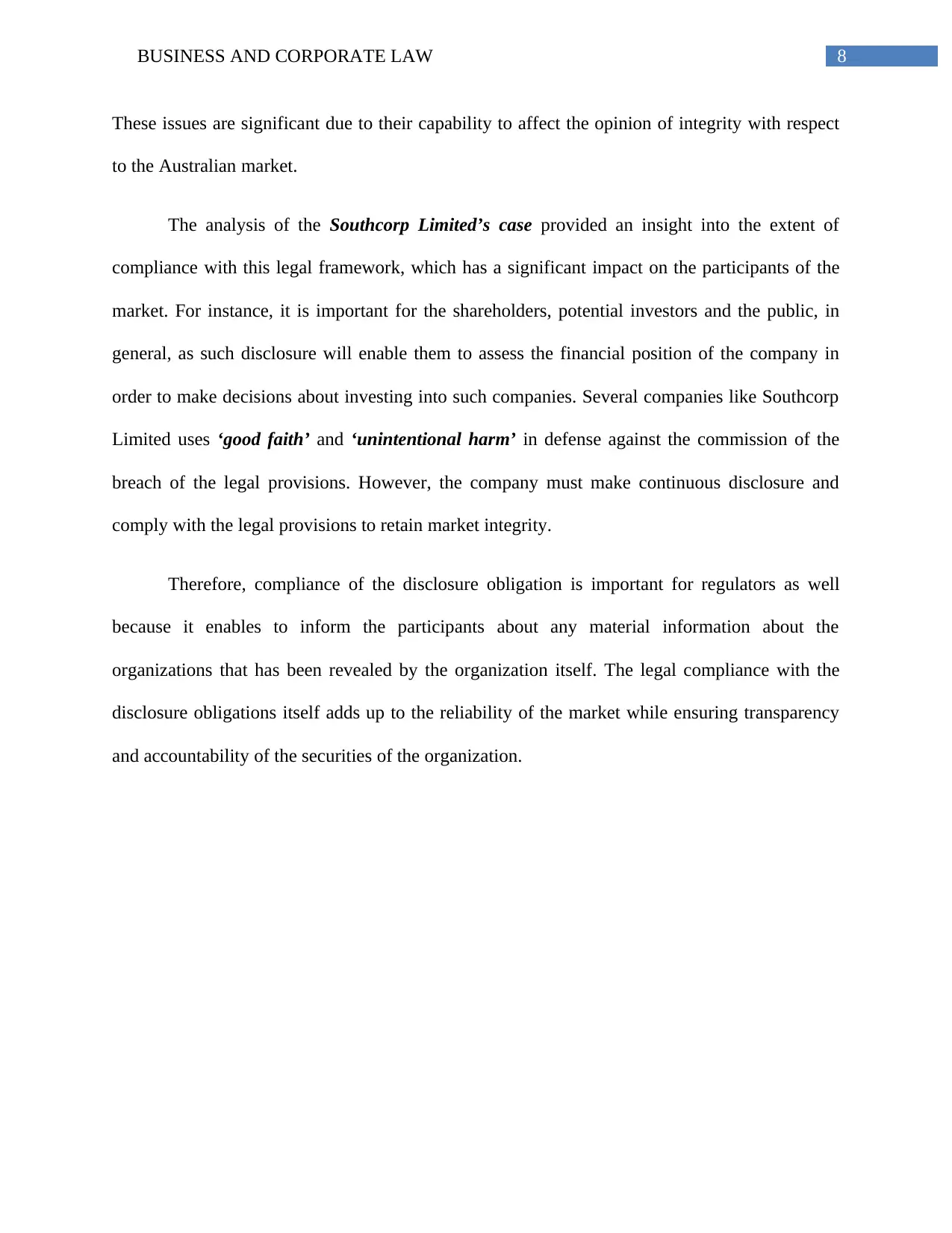
8BUSINESS AND CORPORATE LAW
These issues are significant due to their capability to affect the opinion of integrity with respect
to the Australian market.
The analysis of the Southcorp Limited’s case provided an insight into the extent of
compliance with this legal framework, which has a significant impact on the participants of the
market. For instance, it is important for the shareholders, potential investors and the public, in
general, as such disclosure will enable them to assess the financial position of the company in
order to make decisions about investing into such companies. Several companies like Southcorp
Limited uses ‘good faith’ and ‘unintentional harm’ in defense against the commission of the
breach of the legal provisions. However, the company must make continuous disclosure and
comply with the legal provisions to retain market integrity.
Therefore, compliance of the disclosure obligation is important for regulators as well
because it enables to inform the participants about any material information about the
organizations that has been revealed by the organization itself. The legal compliance with the
disclosure obligations itself adds up to the reliability of the market while ensuring transparency
and accountability of the securities of the organization.
These issues are significant due to their capability to affect the opinion of integrity with respect
to the Australian market.
The analysis of the Southcorp Limited’s case provided an insight into the extent of
compliance with this legal framework, which has a significant impact on the participants of the
market. For instance, it is important for the shareholders, potential investors and the public, in
general, as such disclosure will enable them to assess the financial position of the company in
order to make decisions about investing into such companies. Several companies like Southcorp
Limited uses ‘good faith’ and ‘unintentional harm’ in defense against the commission of the
breach of the legal provisions. However, the company must make continuous disclosure and
comply with the legal provisions to retain market integrity.
Therefore, compliance of the disclosure obligation is important for regulators as well
because it enables to inform the participants about any material information about the
organizations that has been revealed by the organization itself. The legal compliance with the
disclosure obligations itself adds up to the reliability of the market while ensuring transparency
and accountability of the securities of the organization.
⊘ This is a preview!⊘
Do you want full access?
Subscribe today to unlock all pages.

Trusted by 1+ million students worldwide
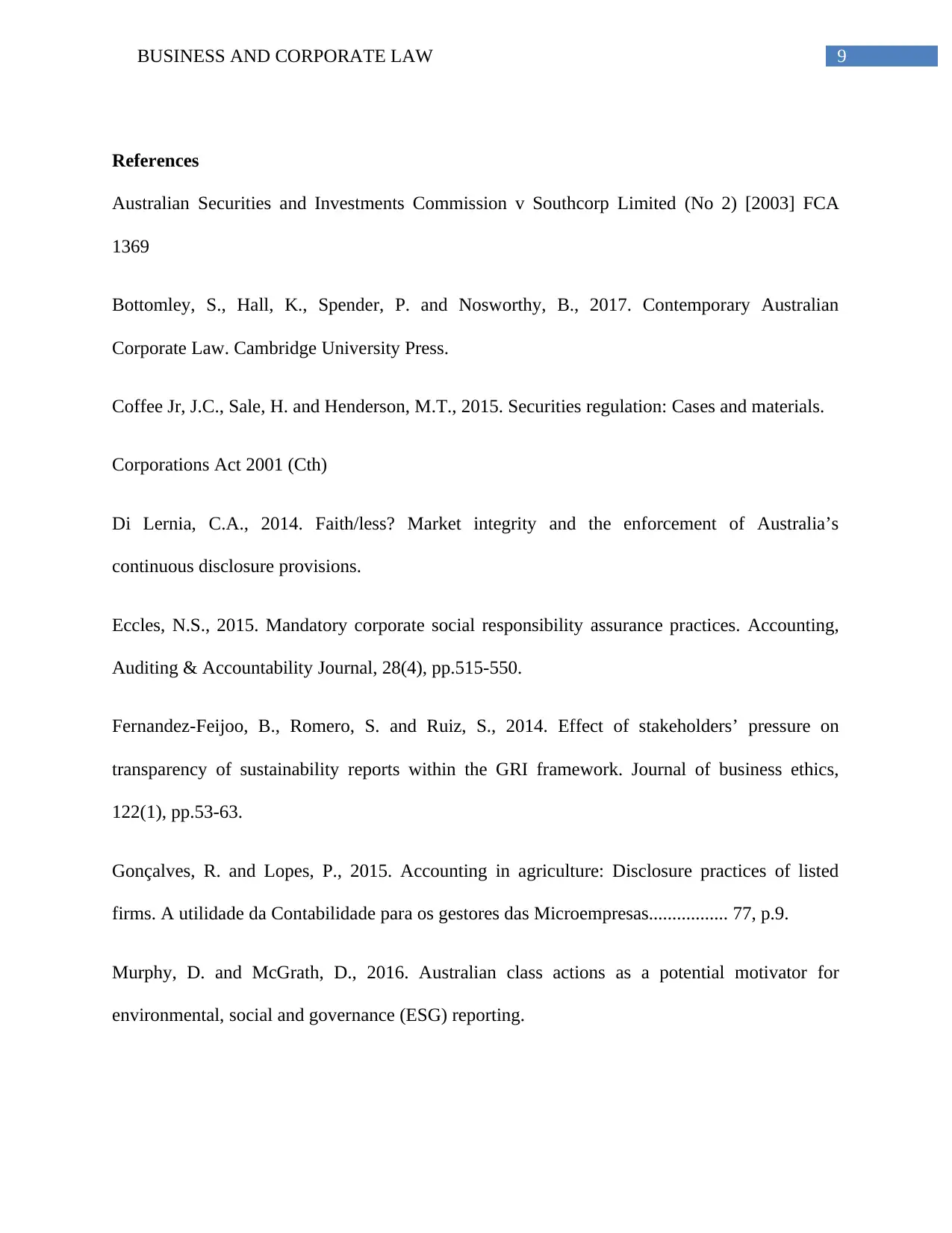
9BUSINESS AND CORPORATE LAW
References
Australian Securities and Investments Commission v Southcorp Limited (No 2) [2003] FCA
1369
Bottomley, S., Hall, K., Spender, P. and Nosworthy, B., 2017. Contemporary Australian
Corporate Law. Cambridge University Press.
Coffee Jr, J.C., Sale, H. and Henderson, M.T., 2015. Securities regulation: Cases and materials.
Corporations Act 2001 (Cth)
Di Lernia, C.A., 2014. Faith/less? Market integrity and the enforcement of Australia’s
continuous disclosure provisions.
Eccles, N.S., 2015. Mandatory corporate social responsibility assurance practices. Accounting,
Auditing & Accountability Journal, 28(4), pp.515-550.
Fernandez-Feijoo, B., Romero, S. and Ruiz, S., 2014. Effect of stakeholders’ pressure on
transparency of sustainability reports within the GRI framework. Journal of business ethics,
122(1), pp.53-63.
Gonçalves, R. and Lopes, P., 2015. Accounting in agriculture: Disclosure practices of listed
firms. A utilidade da Contabilidade para os gestores das Microempresas................. 77, p.9.
Murphy, D. and McGrath, D., 2016. Australian class actions as a potential motivator for
environmental, social and governance (ESG) reporting.
References
Australian Securities and Investments Commission v Southcorp Limited (No 2) [2003] FCA
1369
Bottomley, S., Hall, K., Spender, P. and Nosworthy, B., 2017. Contemporary Australian
Corporate Law. Cambridge University Press.
Coffee Jr, J.C., Sale, H. and Henderson, M.T., 2015. Securities regulation: Cases and materials.
Corporations Act 2001 (Cth)
Di Lernia, C.A., 2014. Faith/less? Market integrity and the enforcement of Australia’s
continuous disclosure provisions.
Eccles, N.S., 2015. Mandatory corporate social responsibility assurance practices. Accounting,
Auditing & Accountability Journal, 28(4), pp.515-550.
Fernandez-Feijoo, B., Romero, S. and Ruiz, S., 2014. Effect of stakeholders’ pressure on
transparency of sustainability reports within the GRI framework. Journal of business ethics,
122(1), pp.53-63.
Gonçalves, R. and Lopes, P., 2015. Accounting in agriculture: Disclosure practices of listed
firms. A utilidade da Contabilidade para os gestores das Microempresas................. 77, p.9.
Murphy, D. and McGrath, D., 2016. Australian class actions as a potential motivator for
environmental, social and governance (ESG) reporting.
Paraphrase This Document
Need a fresh take? Get an instant paraphrase of this document with our AI Paraphraser
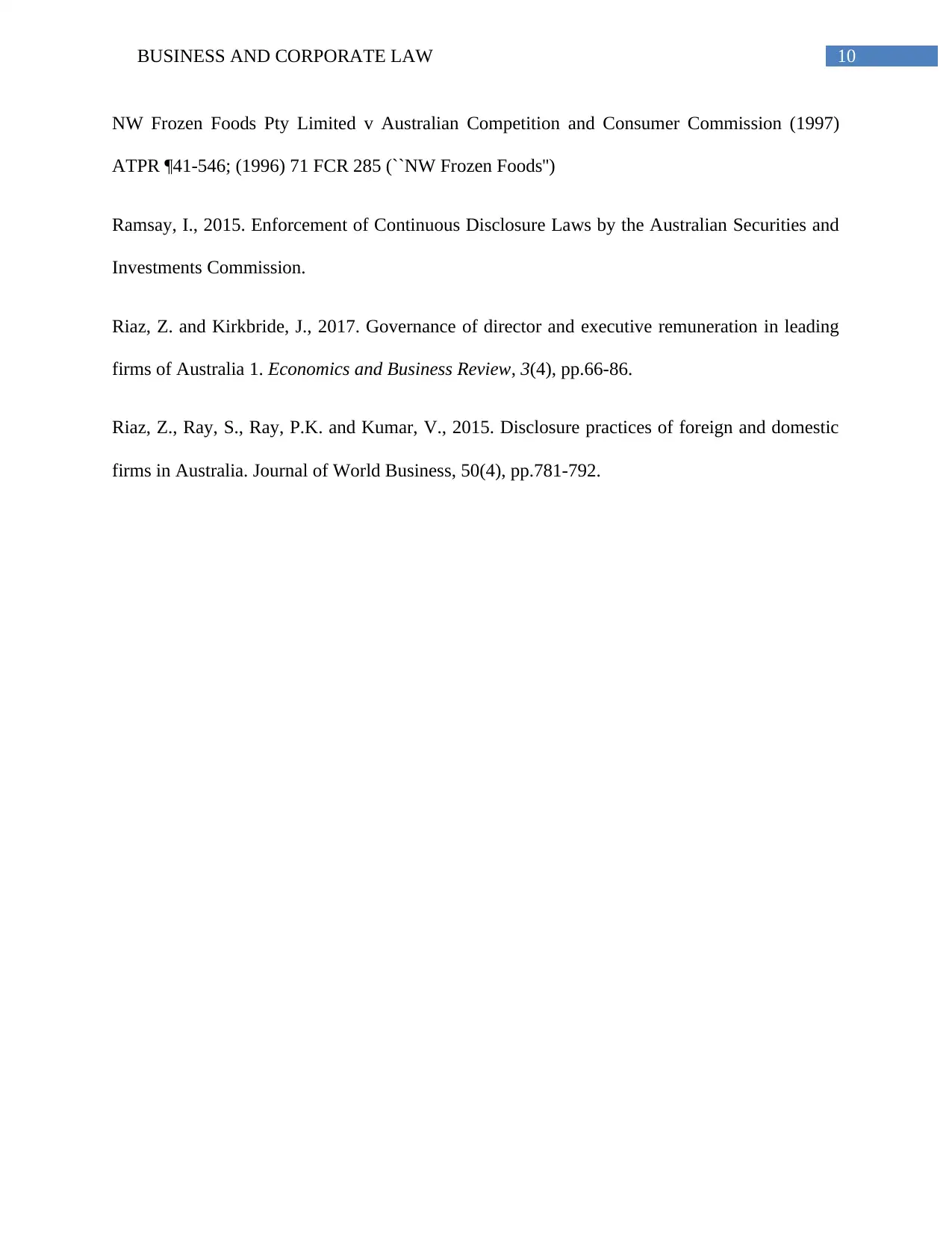
10BUSINESS AND CORPORATE LAW
NW Frozen Foods Pty Limited v Australian Competition and Consumer Commission (1997)
ATPR ¶41-546; (1996) 71 FCR 285 (``NW Frozen Foods'')
Ramsay, I., 2015. Enforcement of Continuous Disclosure Laws by the Australian Securities and
Investments Commission.
Riaz, Z. and Kirkbride, J., 2017. Governance of director and executive remuneration in leading
firms of Australia 1. Economics and Business Review, 3(4), pp.66-86.
Riaz, Z., Ray, S., Ray, P.K. and Kumar, V., 2015. Disclosure practices of foreign and domestic
firms in Australia. Journal of World Business, 50(4), pp.781-792.
NW Frozen Foods Pty Limited v Australian Competition and Consumer Commission (1997)
ATPR ¶41-546; (1996) 71 FCR 285 (``NW Frozen Foods'')
Ramsay, I., 2015. Enforcement of Continuous Disclosure Laws by the Australian Securities and
Investments Commission.
Riaz, Z. and Kirkbride, J., 2017. Governance of director and executive remuneration in leading
firms of Australia 1. Economics and Business Review, 3(4), pp.66-86.
Riaz, Z., Ray, S., Ray, P.K. and Kumar, V., 2015. Disclosure practices of foreign and domestic
firms in Australia. Journal of World Business, 50(4), pp.781-792.
1 out of 11
Related Documents
Your All-in-One AI-Powered Toolkit for Academic Success.
+13062052269
info@desklib.com
Available 24*7 on WhatsApp / Email
![[object Object]](/_next/static/media/star-bottom.7253800d.svg)
Unlock your academic potential
Copyright © 2020–2025 A2Z Services. All Rights Reserved. Developed and managed by ZUCOL.





